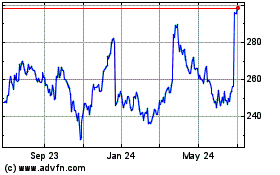By Paul Ziobro
It turns out there is no such thing as free shipping.
Shares of FedEx Corp. tumbled 10% on Wednesday, highlighting
investor concerns about the delivery giant's ability to adapt as
more of its business shifts to delivering less-profitable
e-commerce packages to homes.
The overnight delivery pioneer on Tuesday reported a 40% drop in
fiscal second-quarter profits and cut its earnings targets for the
fourth time in 2019. FedEx has been squeezed by a global drop in
profitable Express air shipments, generally sent between
businesses, and the added costs of building its Ground network,
which is typically associated with package delivery from online
merchants. In the latest quarter, domestic Express parcel volumes
fell 4.1% from a year ago, while Ground shipments rose 3.5%.
Historically, FedEx largely avoided e-commerce shipments,
leaving much of that business to rival United Parcel Service Inc.
and the U.S. Postal Service. Amazon.com Inc., the biggest online
retailer, accounted for just 1.3% of its revenue last year, the
company says.
But FedEx executives decided over the last year to embrace
e-commerce orders, a strategy they said they have been preparing
for years as they watched the growing shift to online shopping and
the deteriorating finances of the Postal Service, its key partner
in handling such packages.
The company has added dozens of facilities to sort packages,
including specialized centers to handle oversize packages, and now
makes regular weekend deliveries.
The transition is shaping up to be one of the most arduous in
FedEx's four-decade history, and some on Wall Street are openly
questioning longtime CEO Fred Smith's strategy.
One reason is that FedEx is chasing growth in a less-profitable
sector. Online parcels are generally small and lightweight, a
combination for lower revenue per package. They are also costly to
deliver since drivers generally drop off one package to individual
homes.
That contrasts with FedEx's larger business delivering shipments
between businesses. In that business, packages are larger and
generate more revenue, while companies often ship multiple packages
to each other. Such shipments tend to be more profitable, but
growth there has stalled.
Operating profit margins in FexEx's e-commerce heavy Ground
business plunged to 6.7% in the fiscal second quarter, down from
12.4% in the first quarter. Executives blamed issues including the
costs of delivering seven days a week, the timing of the Cyber
Monday holiday, a compressed holiday shipping season that required
more staffing and the loss of Amazon as a customer.
"Standing up to [a] 6 and 7 day network was very expensive for
us," Mr. Smith told analysts on a conference call Tuesday evening.
"And we certainly anticipated some of it, but we probably
underestimated the cost of standing it up."
FedEx executives vowed that Ground profit margins would return
to prior levels after the holiday crush. But some analysts were
skeptical, arguing that the timing of Cyber Monday and condensed
holiday calendar were known in advance. UPS, which has invested to
expand and modernize its ground network, has posted strong sales
and profits in recent quarters.
"It is difficult to have clear visibility to improvement on
Ground margin given the magnitude of decline and the number of
moving parts," said UBS analyst Tom Wadewitz. "There remains a
sharp contrast between the favorable trends at UPS and the margin
weakness plaguing FDX."
Mr. Smith defended his strategy to stop delivering packages for
Amazon this year and embrace e-commerce deliveries from companies
like Walmart Inc. and Target Corp. It also has decided to deliver
more of the residential orders that it previously handed off the
Postal Service.
The shift has moved the company into a lower-margin business
where it will compete not just with UPS and Postal Service but also
Amazon, which is ramping up its own delivery network.
"In the last weekend that just finished, we delivered over 14
million packages on Saturday and Sunday," Mr. Smith said on
Tuesday. "We weren't even delivering packages on the weekend a
couple of years ago."
To curb spending, FedEx on Tuesday said it would reduce capacity
in its Express air network, including grounding 10 cargo planes and
cutting flight hours. Previously, Mr. Smith has come under fire for
his reluctance to pare the Express network and the decision to
spend on new jets.
Several analysts asked executives on the conference call whether
the company needs to consider bigger strategic changes, such as
integrating its Express and Ground units. The two currently operate
independently, which can result in employees from each division
visiting the same address on the same day. Mr. Smith has argued the
arrangement is necessary to ensure critical Express deliveries
arrive on time.
"Wall Street is looking for a silver bullet to magically "fix"
FedEx," Rick Paterson, an analyst at Loop Capital Markets, wrote in
a note to clients. "The dual [pickup and delivery] networks may at
some point be a luxury FedEx can no longer afford."
Mr. Paterson said he was surprised "we haven't yet seen any
[investor] activism with regard to FedEx, touting structural
changes such as this one."
Mr. Smith, 75 years old, has run FedEx since he started the
company in 1971. He remains one of the company's largest
shareholders with a nearly 6% stake. But like other investors, he
has suffered investment losses over the last year. FedEx shares,
worth more than $250 last year, were trading Wednesday morning at
$147.19.
Write to Paul Ziobro at Paul.Ziobro@wsj.com
(END) Dow Jones Newswires
December 18, 2019 12:13 ET (17:13 GMT)
Copyright (c) 2019 Dow Jones & Company, Inc.
FedEx (NYSE:FDX)
Historical Stock Chart
From Mar 2024 to Apr 2024

FedEx (NYSE:FDX)
Historical Stock Chart
From Apr 2023 to Apr 2024
